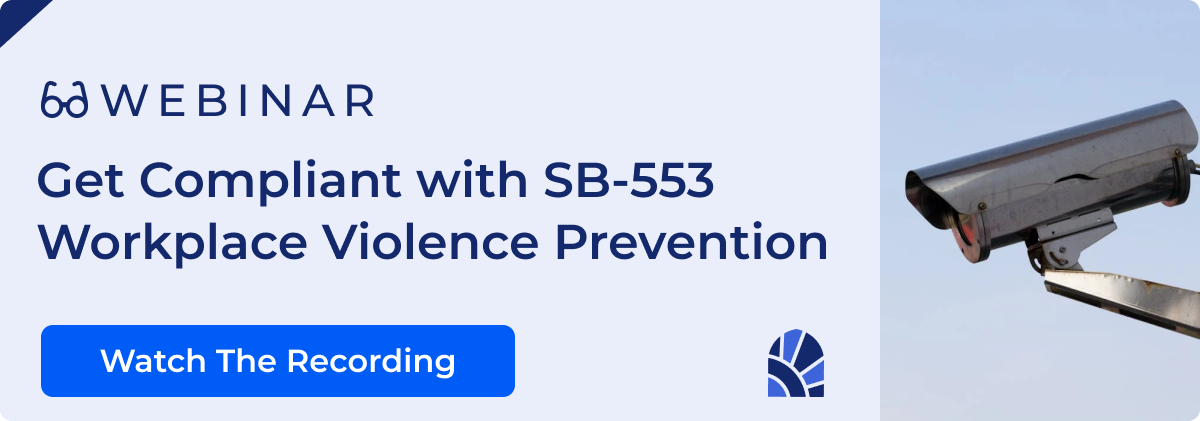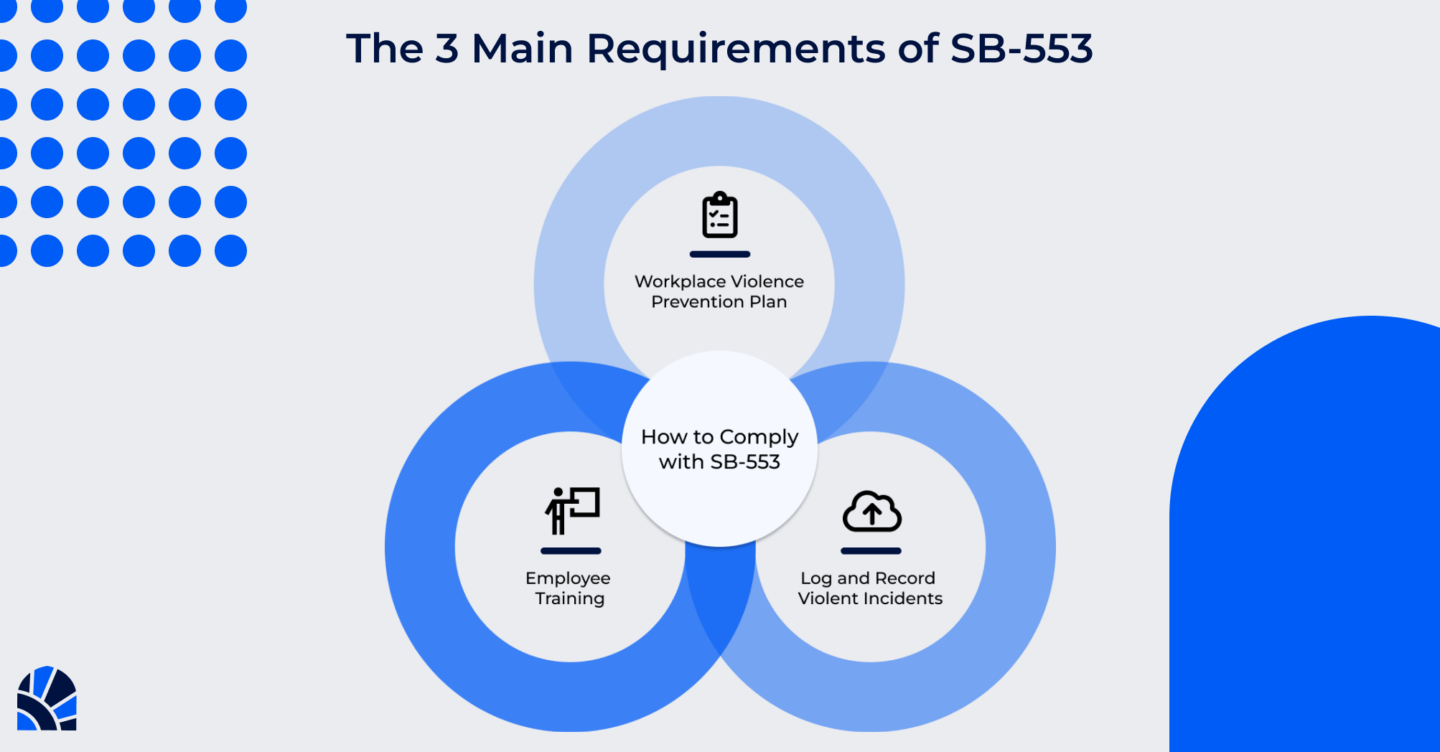The vast majority of businesses and non-profits in California must comply with new workplace violence prevention requirements by July 1st, 2024. In this guide, we’ll explain the basics of Senate Bill 553 and how it applies to California churches and ministries.
What is SB-553?
Senate Bill 553 was passed into law by the California legislature on September 30, 2023 as a move to reduce incidents of workplace violence in the state. The core of SB-553 is the new requirement that the majority of California employers enact their own Workplace Violence Prevention Plan, train employees on that plan and record all incidents of workplace violence.
If your ministry is just now getting compliant with SB-553, we recommend you start with our recent webinar with Church HR Network and BQB Law which also includes the workplace violence prevention checklist and the workplace violence incident log.

Are Churches Exempt from SB-553?
There are no exceptions in SB-553 for churches or religious non-profits, and the vast majority of ministries are subject to the bill.
While there is an exception for certain employers with less than 10 employees, that exception only applies to organizations that do not interact with the public. Because churches, schools, camps and universities operate publicly accessible venues and facilities, they are subject to the bill’s requirements.
Enforcement of SB-553 is regulated by the California Occupational Health and Safety Administration (Cal/OSHA) and failure to comply can carry heavy fines and penalties. While the exact penalty varies by type of organization as well as the seriousness of the infraction, many firms estimate the fines will start at $18,000 to $25,000 per violation.
How to Comply With SB-553
Although SB-553 can be a bit intimidating, compliance is not as difficult as it may first seem.
The bill is comprehensive in its approach, but the major requirements breakdown like this:
- Employers must formalize their safety procedures with a written Workplace Violence Prevention Plan.
- You as the employer must provide training to your employees on this plan and how to contribute.
- Your ministry must log all incidents of workplace violence and follow record keeping guidelines.
Let’s breakdown each section and what it means.

Writing Your Workplace Violence Prevention Plan (WVPP)
The foundation of the law is the new requirement for businesses and non-profits to formalize their Workplace Violence Prevention Plan (WVPP) in writing. This plan can be integrated as a part of your existing Injury and Illness Prevention Plan, or you can maintain this plan as its own separate program.
This written plan must include the following elements:
- Names/Titles of persons responsible for implementing the written WVPP.
- Procedures to obtain the active involvement of employees and authorized employee representatives in developing and implementing the WVPP.
- Methods you as the employer will use to coordinate implementation of the plan with other employers.
- Procedures to ensure that all employees (supervisory and nonsupervisory), comply with the WVPP.
- Procedures to communicate and provide training to employees on workplace violence.
- Procedures to identify, evaluate and correct workplace violence hazards.
- Procedures on how to respond to actual or potential workplace violence, and how to accept and respond to reports of workplace violence, including procedures to prohibit retaliation against employees for reporting workplace violence.
- Procedures for post-incident response and investigation.
- Procedures to review WVPP for effectiveness and revise the plan as needed.
- Procedures or other information required by the division and standards board as being necessary and appropriate to protect the health and safety of employees.
- Employers can prevent and reduce the risk of workplace violence with an established, effectively implemented, and maintained WVPP, along with strong management commitment and the day-to-day involvement of all employees and their authorized representatives.
For a full breakdown of the bill, see the full analysis from Cal/OSHA.
Training Employees on the WVPP
After launching the Workplace Violence Prevention Plan, employers must then train employees on the WVPP. This training must then be repeated on an annual basis going forward.
Training on the plan must include:
- Your plan, how to obtain a copy of the plan at no cost, and how to participate in development and implementation of the plan.
- The definitions and requirements of this section.
- How to report workplace violence incidents or concerns to the employer or law enforcement without fear of reprisal.
- Workplace violence hazards specific to the employees’ jobs, the corrective measures your ministry has implemented, how to seek assistance to prevent or respond to violence, and strategies to avoid physical harm.
- The violent incident log and how to obtain copies of records.
- An opportunity for interactive questions and answers with a person knowledgeable about your plan.
Simply put, the government expects that employees play an active role in building, reviewing and improving workplace violence prevention on an ongoing basis. Your ministry will need to train your employees on how to access the WVPP and associated records, as well as how to ask questions about the plan and report potential workplace hazards.
Workplace Violence Incident Log
The next component of the Workplace Violence Prevention Plan (WVPP) is maintaining a Workplace Violence Incident Log. This log serves as a comprehensive record of all workplace violence incidents and is crucial for tracking patterns, identifying areas for improvement, and ensuring compliance with SB-553.
The incident log must contain detailed information about each incident of workplace violence, including:
- Date, Time, and Location: Record when and where the incident occurred.
- Type of Violence: Classify the incident into one of the four workplace violence types:
- Type 1: Violence by individuals with no legitimate relationship to the workplace.
- Type 2: Violence directed at employees by clients, customers, or patients.
- Type 3: Violence against employees by current or former employees.
- Type 4: Violence committed by someone with a personal relationship with an employee.
- Detailed Description: Provide a thorough description of what happened, including the actions of all parties involved.
- Perpetrator Classification: Note whether the perpetrator was a customer, coworker, supervisor, or someone else.
- Circumstances: Include contextual details such as whether the employee was performing their regular duties, if the area was poorly lit, or if the employee was working alone.
- Type of Incident: Specify whether it involved physical attack, threat, use of a weapon, or other forms of violence.
- Consequences: Document the outcomes of the incident, including any injuries, whether law enforcement was contacted, and what actions were taken to protect employees.
- Reporter Information: Include the name, job title, and date of the person completing the log entry.
Record Keeping Requirements
In addition to logging these records and maintaining the WVPP, employers are now required to maintain ongoing records of violent incident logs and preventative measures taken. These record keeping requirements include:
- The employer must maintain records of workplace violence hazard identification, evaluation, and correction, for a minimum of five years.
- WVPP training records should be kept for a minimum of one year.
- Violence Incident Logs should be kept for a minimum of five years.
- Records of workplace violence incident investigations for a minimum of five years.
- Cal/OSHA Form 300 for five years.

Additional Resources
For more details on creating your Workplace Violence Prevention Plan, read the Cal/OSHA factsheet here as well as the Cal/OSHA Workplace Violence Prevention for General Industry (Non-Health Care Settings).
For 1-1 guidance on implementing SB-553, as well as a Workplace Violence Prevention Model you can use to get started, check out HR 360 by Church HR Network.






